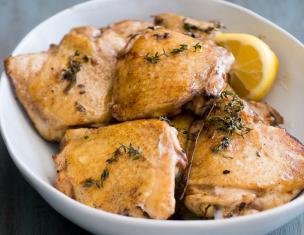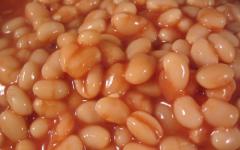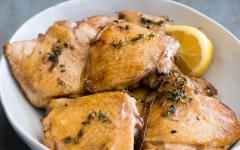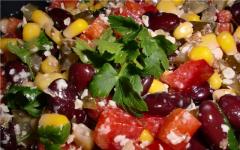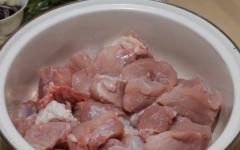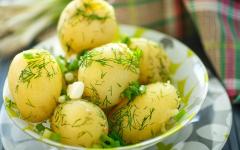This dish is a simplified and more time-efficient version of the classic recipe. If you need to prepare a hearty lunch for a large company very quickly, navy-style pasta with stew is the ideal solution for any housewife.
The benefits and harms of the dish
By choosing durum wheat pasta and chicken stew for the recipe, you can reduce the calorie content of the dish to 150-160 kcal per 100 grams of the finished product.
This food will not cause digestive problems and will be easily absorbed by the body. It can also be used by people watching their weight.
People suffering from intestinal and stomach diseases should avoid pork and the use of butter or cream.
Difficulty, cooking time
To prepare navy-style pasta with stew, you will need a minimum amount of available ingredients and a small amount of time - 30-40 minutes.
The cooking process is greatly facilitated by ready-made meat, which needs to be simmered together with vegetables for about 3 - 4 minutes. Then add the boiled pasta and let it sit for 10 minutes so that it soaks in the vegetable sauce.
Food preparation
Among pasta products, according to their preference, they choose horns, noodles, feathers, shells, vermicelli, spaghetti and other varieties.
A variety of vegetables are also used, in addition to the main ones, onions and carrots; options with tomatoes, bell peppers, mushrooms, zucchini or eggplants are possible.
To add piquancy to the dish, add Parmesan cheese with a bright salty taste or delicate Feta milk cheese.
You can use any kind of stew – chicken, pork, pork-beef, beef, turkey. Stew with chicken will make the most easily digestible and tender dish, with pork it will be fattier, and beef meat will appeal to lovers of lean foods.
The most easily digestible meat for the stomach is poultry; chicken stew can be used in the children's menu.
How to cook?
Main ingredients for 6 servings with a calorie content of 175 kcal/100g:
- tubular pasta – 300 g;
- 1 onion;
- butter – 2 tablespoons;
- 1 can (0.5 l) stew;
- refined vegetable oil – 4 tbsp. spoons;
- seasoning for pasta, pepper, salt, fresh herbs.
Step-by-step preparation of navy-style pasta with stew in the photo:
- Peel the onion and finely chop.

- Place the chopped onion in a frying pan with oil and simmer over low heat until translucent. Then increase the heat and fry for 3 - 5 minutes until golden brown.

- Boil the pasta: bring water to a boil with added salt, place the pasta in it. Cooking time depends on the type of pasta, indicated on the package.

- Once ready, drain the water using a colander and rinse with water if necessary.
- Open a can of stew, place the contents on a plate, and mash large pieces of meat with a fork.

- Add the stew to the pan with the onions, stir, and add salt if necessary.
- Cover the dish with a lid and leave for 4 – 5 minutes.
- Remove the lid, add boiled pasta to the food, add spices and pepper, stir.

- Add butter to enhance the taste. Close the lid and simmer for 5 – 6 minutes.
- After the allotted time, transfer the dish to portioned plates and sprinkle with fresh chopped herbs.

Cooking options
All recipes for preparing this dish practically do not differ in technology; they can differ in the quantity and composition of ingredients.
Navy pasta with stew and tomato paste
Required Products:
- stew – 400 g;
- onion – 150 g;
- spirals – ½ pack (400 g);
- 1 tbsp. spoon of tomato paste;
- carrots – 150 g;
- 4 tbsp. spoons of vegetable oil;
- greens, garlic;
- pepper, spices, salt.

Preparation:
- Peel and wash the vegetables, chop.
- Place chopped vegetables into heated refined oil.
- The readiness of vegetables is determined by their softness and acquisition of a golden hue.
- Dilute the tomato paste with water (50 ml), pour it into a bowl with the vegetables, add salt, stir, and add spices.
- Simmer the sauce for 5 minutes.
- Drain the water from the boiled pasta and rinse off any mucus.
- Place the spirals in the pan, cover with a lid, and simmer for 8 minutes.
- Turn off the heat, remove the lid, add chopped fresh parsley and dill, chopped garlic.
- Leave the dish to steep for 10 minutes with the lid closed.
- When hot, place into plates and serve.
Yield: 10 servings, calorie content per 100 g: 175 kcal.
Ingredients for 6 servings with a calorie content of 165 kcal / 100 g:
- chicken stew – 300 g;
- pasta horns – 200 g;
- onion – 150 g;
- ground bay leaf – 5 g;
- olive oil – 80 g;
- salt – 5 g.

Preparation:
- Peel the onion, cut into small pieces.
- Pour olive oil into the multicooker bowl, put chopped onion, turn on the “Fry” mode for 15 minutes.
- Fry with the lid open, stirring.
- Remove the meat from the jar and divide into small pieces.
- After finishing the “Frying” mode, add stewed chicken meat to the onions, add the horns, add bay leaf, and salt. Pour in enough water to cover the pasta and mix everything well with a wooden spatula.
- Set the “Grains” mode (20 minutes), close the lid.
- After cooking is complete, place the pasta in a large, deep plate. Serve the dish hot with herbs and vegetables.
Video recipe:
Navy noodles with stewed meat and cheese
Ingredients for 8 servings (calorie content of 100 grams of product – 180 kcal):
- beef stew – 400 g;
- noodles or pasta – 300 g;
- champignon mushrooms – 200 g;
- onion – 200 g;
- hard cheese – 150 g;
- oregano – 5 g;
- salt.

Preparation:
- Cut the mushrooms into slices, the onions into half rings.
- Place the frying pan on the fire, after heating to the desired temperature, pour in vegetable oil, add onions and mushrooms, and add salt.
- Fry until all the moisture has evaporated and the onion turns golden.
- Chop the beef pieces, place in a frying pan, sprinkle with oregano, fry for 4 minutes with the lid closed.
- Open the lid, put boiled spaghetti in the pan, simmer on low heat for 5 minutes.
- Grate the cheese on a grater with medium holes.
- Place the finished navy noodles with stew on a large dish, sprinkle cheese on top.
Navy pasta with stew and Bechamel sauce
Required Products:
- spaghetti – ½ pack (350 g);
- butter – 2 tbsp. spoons;
- Parmesan cheese – 60 g;
- milk – 0.5 liters;
- meat stew – 350 g;
- egg – 1 pc.;
- olive oil – 50 g;
- onion – 1 pc.;
- flour – 20 g;
- greenery;
- salt, spices, ground nutmeg.

Preparation:
- Chop the butter with a knife, place in a saucepan, and melt until liquid.
- Pour the flour into the butter and stir quickly with a whisk to prevent lumps from forming. Keep on fire until the mixture turns golden.
- Pour in cold milk, add 1 teaspoon of ground nutmeg, cook for 10 minutes, stirring regularly.
- Separate the yolk from the white.
- Remove the saucepan from the heat, add the egg yolk and Parmesan cheese, grated on a fine grater.
- Mix well, you should get a smooth mass with the consistency of thick sour cream.
- Sauté finely chopped onion in refined olive oil until golden brown.
- Divide the stew into small pieces, mix with half-cooked onion, and fry for 5 minutes.
- Boil pasta, drain and rinse.
- Combine the washed products with the meat sauce in a bowl, mix and continue to simmer for another 10 minutes with the lid closed.
- Place the finished pasta on a large dish, make a well in the middle, and pour Bechamel sauce into it. Serve hot.
Yield – 8 servings, caloric content of 100 grams of product – 185 kcal.
Navy noodles with stew and cream sauce
List of products:
- stew – 400 g;
- onion – 150 g;
- cream 20% – 150 ml;
- noodles – 350 g;
- vegetable oil – 50 ml;
- salt, black and hot pepper, seasonings.

Preparation:
- Sauté finely chopped onion in vegetable oil.
- Mix the stewed meat with onions and fry for 4 minutes.
- Pour in the cream, salt, ground pepper and seasonings to taste.
- Simmer with the lid open for 5 minutes.
- Place the boiled noodles into the sauce and stir.
- Heat on fire for 5 - 6 minutes.
- Close the lid and let it brew for 10 minutes.
- Serve hot with fresh vegetables and herbs
Yield – 8 servings, caloric content of 100 g of product – 180 kcal.
Navy spaghetti with stewed meat and tomatoes
Ingredients:
- tomatoes – 250 g;
- onion – 150 g;
- bell pepper – 150 g;
- stewed pork – 300 g;
- spaghetti – 300 g;
- vegetable oil – 4 tablespoons;
- cream – 1 tbsp;
- salt, spices.

Preparation:
- Peel the onion and remove the grains from the bell pepper. Wash the vegetables and chop finely.
- Pour vegetable oil into a hot frying pan, then add onions and peppers and simmer until soft.
- Place the tomatoes in boiling water for 2 minutes, then peel them and cut them into cubes.
- Add tomatoes to the pan, add salt, spices and seasonings.
- Turn the heat to low and simmer covered for 15 minutes until a homogeneous mass forms.
- Add cream to vegetables and stir. You should get a thick sauce.
- Remove the meat from the can, divide it into small pieces and place it in the pan.
- Increase the heat and continue frying for another 3 - 5 minutes.
- Place the boiled and washed spaghetti in a frying pan with the sauce, stir, and leave to steep under the lid closed for 10 minutes.
- The finished dish is served hot.
Makes 8 servings, calorie content per 100 g of product – 165 kcal.
First of all, you need to prepare a vegetable sauce with meat - cutting and stewing onions, carrots and other products, frying the meat.
When purchasing stew, it is better to opt for a glass jar, in which you can see the size of the pieces of meat and its quality. There should not be a lot of broth in the jar, the product should have an even pink color, without dark spots, skins and cartilage.
It is imperative to study the composition; it should not contain unnecessary components, flavor enhancers and preservatives.
It is better to add fresh herbs to the dish after stewing, this way the vitamins and microelements contained in it will be preserved, and the food will become more aromatic.
Calorie content of pasta (dry):~ 340 kcal, boiled:~ 175 kcal*
* average value per 100 g, depends on the type of flour, type of pasta and cooking methods
Pasta is a popular dish characterized by its nutritional value and high energy value. Different types - spaghetti, noodles, pasta - are used to prepare casseroles, soups and cold appetizers.
How many calories are in 100 grams of pasta?
Pasta is not only tasty, but also a healthy product. Due to the content of vitamin B in products made from durum wheat, a person feels a surge of strength and energy for a long time. Amino acids help normalize sleep and mood, and fiber helps remove all harmful substances from the body and restores intestinal function.
The Italian product differs from the domestic one in composition. In the first case, only flour and water are used, in the second, eggs and butter are added.
Flour for making pasta can be of baking, hard, or glassy varieties. The first option is considered more beneficial for the body. Depending on the type, the calorie content of the product (dry) is 320-360 kcal. About the same numbers for or.
For your diet, it is better to choose products made from rice or buckwheat flour.
The products of the well-known brand “Makfa” (only durum wheat is used) have 345 kcal, the products do not become overcooked and keep their shape. Barilla has a higher figure - 360 kcal. Spaghetti, bows, lasagna sheets, feathers are distinguished by their excellent taste and high quality. Manufacturers can add tomatoes, spinach, carrots, spices and herbs to create beautiful and more savory pasta.
Calorie content of boiled and fried pasta
The energy value of pasta depends not only on its type, but also on the products that are added during the cooking process. When cooking, the numbers decrease by more than 2 times (about 120 kcal per 100 grams). This is due to the increase in volume of products after boiling.
One standard serving of boiled pasta (150 g) contains 180 kcal.
Additives (butter, sauces, cheese, sour cream) significantly change the value of the finished dish. For boiled products with butter (2 tablespoons), the indicator will be almost 180 kcal per 100 g. Read about the properties and calorie content of butter.
Nutritionists advise replacing animal oil with vegetable oil. In the homeland of pasta, olive oil is used; when it is added, the energy value is reduced by 20 units (160 kcal). Get to know us in our article. If you want to fry pasta in oil, you should pay attention to the high calorie content of the finished dish - more than 190 kcal.
Table of calorie content of the product (hard, boiled, with cheese, etc.)
You can find out what energy value different types of pasta have from the calorie content table per 100 g.

Calorie content of pasta dishes
If you boil pasta and add cheese to it, you will get a fairly high-calorie dish (330 kcal) that is not suitable for dietary nutrition. You can reduce the indicator if you use low-fat varieties of dairy product in an amount of no more than 1 tablespoon. You can read about it in our publication.
Popular dishes where pasta is the main ingredient:
- baked with egg – 152 kcal;
- with beef stew – 190 kcal;
- with minced meat (navy style) – 230 kcal;
- with pieces of beef – 215 kcal;
- noodle soup – 90 kcal;
- with chicken breast – 290 kcal;
- with Bolognese sauce – 200 kcal.
The most dietary option is durum spaghetti with the addition of vegetables or seafood. The value of such a dish will be only 110-120 kcal.
The quality of the paste, beneficial properties, and energy value depend on the varieties of cereal crops used and manufacturing technologies. During the diet, you should limit consumption to one small serving every 2-3 days.
One of the most popular everyday dishes among Russian residents is all kinds of pasta. Navy pasta with minced meat is especially tasty, the calorie content of which can vary depending on what meat it is made from.
To prepare the dish, it is recommended to buy products made from durum wheat varieties, since durum wheat pasta is most suitable for weight loss: it will not harm the figure and will allow you to maintain the normal functioning of the digestive system. The relatively high calorie content of navy-style pasta with pork or other meat is due to the content of a large amount of complex carbohydrates and proteins. It is better to use minced lean beef and pork, but chicken and even stew are also suitable.
How are calories in navy pasta calculated?
In an uncooked state, pasta contains approximately 350 kcal per 100 grams, and after cooking it decreases to 130-160, since the product more than doubles in volume.
If butter is added to the recipe with minced meat, the calorie content of the pasta will increase significantly, but you will get a complete dish, filled with numerous useful substances and energy.
To calculate the calorie content of naval pasta, you need to take into account the method of its preparation, or rather the ingredients used:
- Navy pasta with minced chicken has a calorie content of 130 to 145 kcal;
- a dish with turkey contains up to 190 kcal;
- in navy pasta with minced beef, the calorie content is about 280 kcal;
- calorie content of navy-style pasta with lean pork is approximately 290 kcal;
- calorie content of pasta with stewed meat is from 250 to 350 kcal.
Also, the nutritional value of the prepared product depends slightly on the oil used. To reduce fat content and give the product a refined taste, use olive oil instead of butter.
How to reduce the number of calories in pasta the navy way?
To reduce the calorie content of navy pasta with minced meat, you can exclude certain components from the recipe. Optional ingredients include a number of ingredients: sour cream, mayonnaise, tomato paste, ketchup, butter. For many people, it is surprising how this dish can be prepared without vegetable fats, but in reality its taste will not deteriorate at all.
To make the minced meat soft and add extra flavor, simmer it in a small amount of water. In order not to harm your figure with calories from pasta with stewed meat or minced meat, do not eat them in the evening. It is better to have breakfast or lunch with this dish, getting a good supply of energy until the end of the day.
Pasta is a favorite and very popular food product. For proper dietary consumption of pasta dishes, it is necessary to wisely choose the time of consumption and calculate their calorie content in accordance with the composition.
One of the most famous pasta dishes is navy pasta, the nutritional composition of which depends on the type of meat ingredients used.
The benefits of dishes with pastaPasta is rich in beneficial nutrients that are necessary for the normal balanced functioning of the human body. Particularly valuable are pasta made from durum wheat, which contains:
- a large amount of plant proteins, proteins and lipids that enrich and strengthen muscle fibers, contributing to the proper digestive process;
- natural dietary fiber and carbohydrates perfectly saturate the body and maintain a feeling of fullness for a long time;
- a wide range of minerals, such as sodium, magnesium, potassium, chlorine, iron, zinc, phosphorus, calcium, allows you to replenish the supply of essential microelements;
- The vitamin composition of pasta includes thiamine B1, riboflavin B2, folate B9, choline B4, tocopheryl E, beta carotene, niacin PP, retinol A, biotin H, which makes it possible to maintain a sufficient level of energy, tone and metabolism.
How to correctly calculate the calorie content of pasta and dishes with it?
Dry pasta contains on average about 350 kcal per 100 g; when cooked, this figure decreases to 135-160 kcal. When you add butter and minced meat to pasta, you get a complete dish that can saturate the body with a lot of useful substances and powerful energy potential. It’s not difficult to calculate the calorie content of pasta with minced meat.
When counting the calories of navy pasta, you need to add the energy value of meat per 100 g of the finished product:

How many calories it contains also depends on the type of oil used. To reduce fat content and give this dish a piquant flavor, you can use olive oil instead of butter or lard.
Pasta can be used as a main lunch dish even if you are on a diet, since its composition significantly enriches the body with nutrients, saturates and enriches it with energy for a long time, and allows you to reduce the calorie content of dinner to a minimum.
Navy pasta rich in vitamins and minerals such as: vitamin A - 26.1%, beta-carotene - 28.2%, vitamin B1 - 25.8%, vitamin E - 20.1%, vitamin PP - 13.8%, phosphorus - 12.7%, cobalt - 49.7%, copper - 22.9%, molybdenum - 16.3%, chromium - 14.9%
What are the benefits of Navy pasta?
- Vitamin A responsible for normal development, reproductive function, skin and eye health, and maintaining immunity.
- B-carotene is provitamin A and has antioxidant properties. 6 mcg of beta carotene is equivalent to 1 mcg of vitamin A.
- Vitamin B1 is part of the most important enzymes of carbohydrate and energy metabolism, providing the body with energy and plastic substances, as well as the metabolism of branched amino acids. A lack of this vitamin leads to serious disorders of the nervous, digestive and cardiovascular systems.
- Vitamin E has antioxidant properties, is necessary for the functioning of the gonads and heart muscle, and is a universal stabilizer of cell membranes. With vitamin E deficiency, hemolysis of erythrocytes and neurological disorders are observed.
- Vitamin PP participates in redox reactions of energy metabolism. Insufficient vitamin intake is accompanied by disruption of the normal condition of the skin, gastrointestinal tract and nervous system.
- Phosphorus takes part in many physiological processes, including energy metabolism, regulates acid-base balance, is part of phospholipids, nucleotides and nucleic acids, and is necessary for the mineralization of bones and teeth. Deficiency leads to anorexia, anemia, and rickets.
- Cobalt is part of vitamin B12. Activates enzymes of fatty acid metabolism and folic acid metabolism.
- Copper is part of enzymes that have redox activity and are involved in iron metabolism, stimulates the absorption of proteins and carbohydrates. Participates in the processes of providing oxygen to the tissues of the human body. Deficiency is manifested by disturbances in the formation of the cardiovascular system and skeleton, and the development of connective tissue dysplasia.
- Molybdenum is a cofactor for many enzymes that ensure the metabolism of sulfur-containing amino acids, purines and pyrimidines.
- Chromium participates in the regulation of blood glucose levels, enhancing the effect of insulin. Deficiency leads to decreased glucose tolerance.
You can see a complete guide to the most useful products in the appendix.




